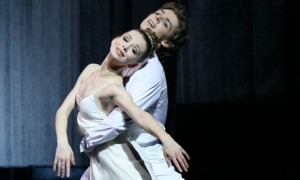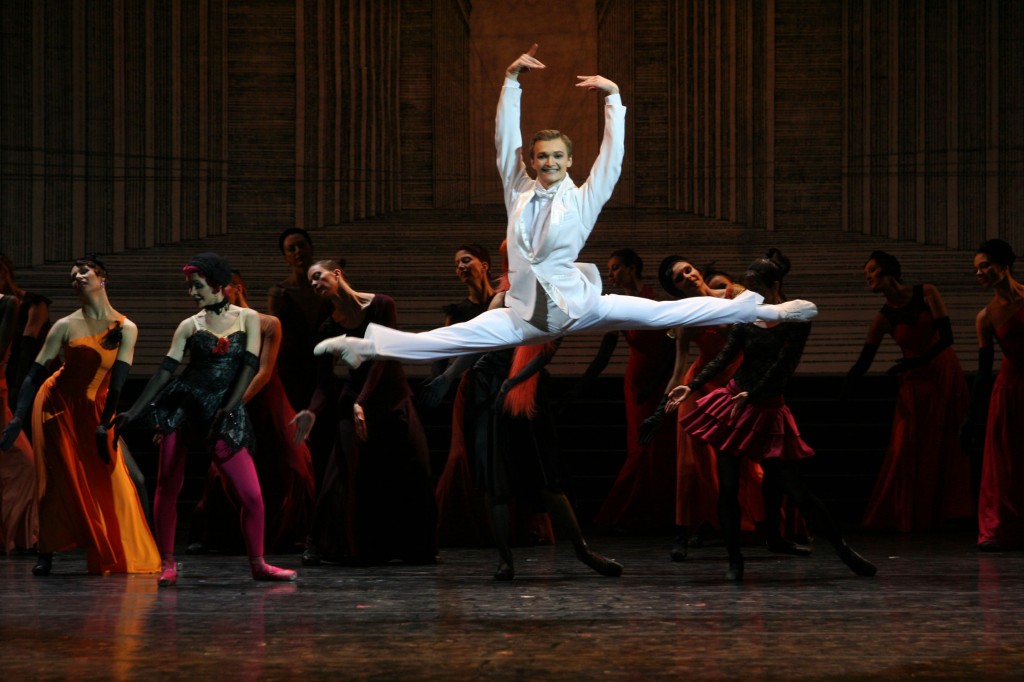Dance Review: The Mariinsky Ballet – An Updated, Urbanized “Cinderella”
The 1930s urban update of Cinderella proffers some clumsiness, but the dancing by the expert members of the Mariinsky Ballet is a treat.
The Mariinsky Ballet. At the Kennedy Center, Washington DC, through October 21.
By Iris Fanger
During the years when Boston was on the touring circuit for traveling ballet companies, a fan could, on occasion, see one or another of the major troupes on tour. Balletomanes will remember visits from the Royal Ballet (England), New York City Ballet, the Bolshoi Ballet, the Moiseyev (the massive folk dance institution from Russia), and Sarah Caldwell’s Making Music Together (1988), which brought a number of Russian ballet and opera stars to town.
Alas, this no longer is that true; in truth, we now count ourselves lucky to host appearances from smaller, contemporary American companies. The Boston-based fan must now travel to New York or Washington D.C. to take the measure of major dance troupes, as I did this past week to see the Maryiinsky Ballet of St. Petersburg (formerly the Kirov of Leningrad) in Alexei Ratmansky’s Cinderella at the Kennedy Center. Given the quest by the Boston Ballet to be reckoned among the most important companies in the world, it seems to me that it is useful to check out the competition.
We must leave home to see works by A-list choreographer Ratmansky, a former dancer and one-time director of the Bolshoi Ballet, now choreographer-in-residence for American Ballet Theatre in New York. He has re-drafted a number of the full-length classics: The Nutcracker for ABT, the Soviet-era Bright Stream (originally for the Bolshoi Ballet, 2003), The Little Humpbacked Horse for the Maryiinsky, plus Cinderella, set to Sergei Prokofiev’s well-known score. Ratmansky’s newest, full-length, evening work, paired with Dmitri Shostakovich’s Symphony No. 9, is having its world premiere this weekend at ABT’s fall season in New York. The closest he’s come to Boston was the performance of one short work, Bizet Variations, by the State Ballet of Georgia at Jacob’s Pillow in 2010.
Since its 1945 premiere in Russia, the Cinderella choreographed by Sir Frederick Ashton serves as the venerable archetype for the succeeding versions set to Prokofiev’s score. Sir Fred, in drag, created the role of one of the silly step sisters for the Royal Ballet. (His sibling was played by Robert Helpmann.) Ashton’s elaborate piece reprised nearly every nuance of the familiar tale: Cinderella dancing with a broom-stick in Act I, the transformation of the beggar woman into the Fairy godmother, and above all, the memorable dances of the Fairies in the Four Seasons interlude. The Boston Ballet has twice presented Canadian choreographer James Kudelka’s updated Cinderella, with great success.
In deciding to modernize the story, Ratmansky has made some unfortunate choices. He’s kept the Fairy Tramp, as she is called, a bag lady rather than transforming her into a lovely illusion and changed the Four Seasons from women into a quartet of men, the latter vaguely suggesting overgrown, preening birds. In Act III, when the Prince travels to find Cinderella, he stops in a Spanish brothel and then a gay club, where the men try to seduce him into their company—a dubious suggestion of modern day sexuality. Other than the pair of pas de deux for Cinderella and her Prince, beauty was clearly not on Ratmansky’s agenda.
The time and place has been moved from fairyland central to a 1930s industrial, urban landscape, complete with a black-and-white, grid-like, city skyline for the front curtain. Large, iron stairways flank the sides of the stage in Cinderella’s house (designed by Utkin and Yevgeny Monakhov). A huge, circular, metal chandelier that rotates into a clock hangs menacingly over the stage. The Act II ballroom scene takes place within a towering, vaulted ceilinged space that looked like the Washington DC Metro station at Foggy Bottom, where a red shuttle bus waits to ferry viewers to the Kennedy Center. The ball costumes (designed by Elena Markovskay) mirror the clingy, jersey affairs worn by glamorous film stars of the era, topped by little cocktail hats; the men wear black evening dress with tails, except for the Prince, garbed in a white suit like the M.C. of a dreamland circus. The décor is decidedly cool and sparse—suitable for packing up to take on tour but of little use when it comes to suggesting a happier life to come.
Never mind. The treat is in the dancing by the expert company, despite the odd, jagged elbow/twisted torso choreography for the corps de ballet in the ballroom scene. On stage at the Kennedy Center were 58 Maryiinsky dancers, most of them no doubt trained in the Vaganova school in St. Petersburg, whose technique arguably still sets the world wide ballet standard. The cast was led by the rapturous, young Maria Shirinkina, a second soloist making her debut in the title role. Principal dancer, Vladimir Shklyarov performed as The Prince, throwing off sky-high jumps and stage circling linked turns as if he had just won his multiple competition medals.
Shirinkina was properly waif-like, making her entry into the ball by peering around a large pillar as if she suspected she didn’t belong there but blossoming into a vision of lyricism and abandon in her newly-found true-love’s arms during the first pas de deux. The folding and unfolding her arms and legs was so sharp it was as if her body was a letter being creased to fit into an envelope. The pair of dancers brought a welcome level of tenderness to the otherwise brittle, quasi-sophisticated story-telling.
Ekaterina Kondaurova portrayed the red fright-wigged Stepmother as a harrigan, with frequent stiletto jabs of her legs in Cinderella’s direction. Kondaurova created the role 10 years ago at the ballet’s Mariinsky premiere.
Note: After two years as a member of the Boston Ballet corps de ballet, Keenan Kampa joined the Maryiinsky company in June, 2012. The tall, blond, and blue-eyed Kampa was the first American graduate of the Vaganova School of St. Petersburg in 2010. She was listed as a coryphée—one step up from the corps—in the company line-up for the Kennedy Center engagement.




More evidence that seeing major dance companies from around the country and the world is becoming more difficult. During the month of August the Saratoga Performing Arts Center in upstate N.Y. hosts the New York City Ballet, as it has since its opening in 1966.
Unfortunately, the SPAC administration has seen fit to cut the ballet season to two weeks — due to alleged budgetary considerations.